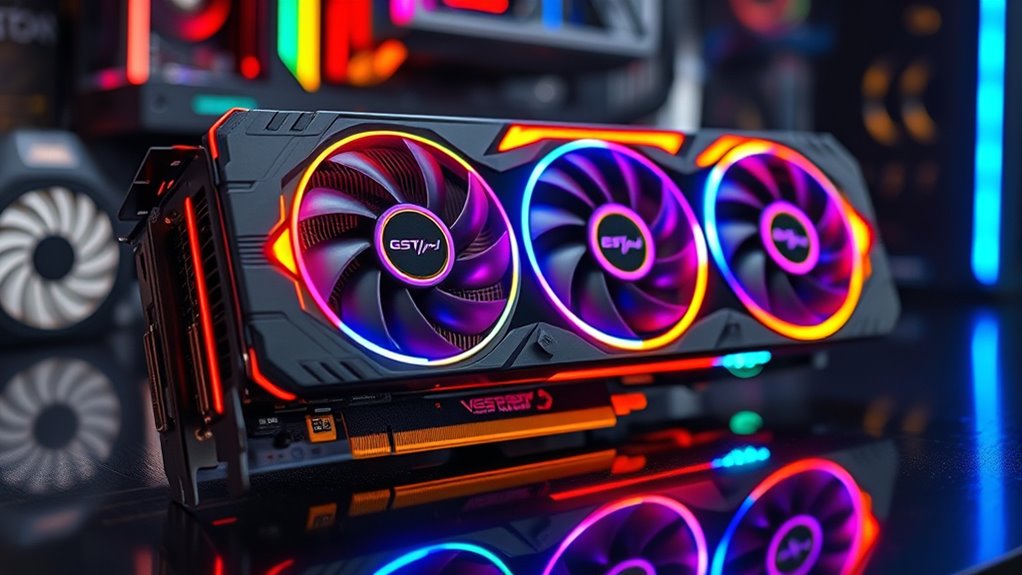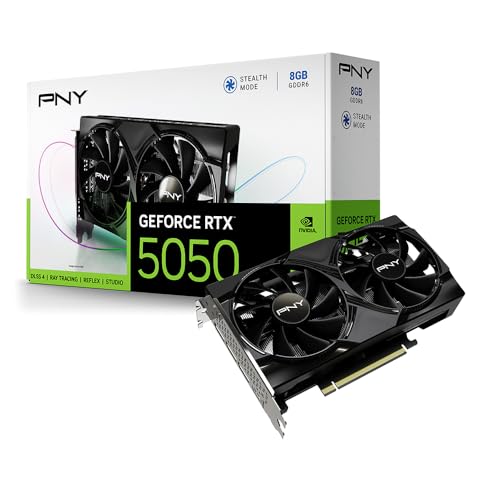If you’re looking for the best premium graphics cards for gaming rigs in 2025, I recommend checking out top-tier models like the ASUS RTX 5070 Ti, GIGABYTE RTX 3060 OC, and ASUS RTX 5080, which combine cutting-edge architecture, ample VRAM, and excellent cooling solutions. These cards support 4K and beyond, ensuring smooth gameplay and future-proofing your setup. Stick around, and you’ll discover detailed insights to help you choose the perfect GPU for your needs.
Key Takeaways
- Highlights top-tier GPUs like ASUS RTX 5080 and GIGABYTE RTX 5070 Ti, offering advanced performance and future-proof features for gaming and professional use.
- Covers support for high resolutions up to 8K, high frame rates, and immersive VR experiences, suitable for demanding titles and workloads.
- Details cooling solutions, build quality, and compatibility to ensure optimal thermal performance and longevity in premium gaming rigs.
- Provides insights into power requirements, connectivity options, and size considerations for seamless integration into high-end systems.
- Recommends GPUs tailored for various user profiles, including gamers, creators, and budget-conscious users seeking premium performance.
ASUS TUF Gaming GeForce RTX 5070 Ti 16GB Graphics Card
If you’re looking for a high-performance GPU that can handle demanding games and professional tasks with ease, the ASUS TUF Gaming GeForce RTX 5070 Ti 16GB is an excellent choice. Built on NVIDIA Blackwell architecture, it features enhanced cooling, durable military-grade components, and robust power delivery. OC mode boosts clock speeds to 2610 MHz, while DLSS 4 and AI performance reach 1484 TOPS. With 16GB GDDR7 VRAM, it easily handles 2K, 4K, and even 8K gaming. The sleek white design, sturdy build, and efficient thermal performance make it not just powerful but also visually appealing and reliable for intensive workloads.
Best For: gamers and content creators seeking a high-performance, durable GPU capable of handling 2K to 8K gaming and professional workloads with excellent cooling and aesthetic appeal.
Pros:
- Exceptional gaming performance at 1440p, 4K, and 8K resolutions with stable frame rates and DLSS 4 support
- Robust build quality featuring military-grade components, enhanced cooling, and sleek design
- Plenty of VRAM (16GB GDDR7) and high clock speeds (up to 2610 MHz OC mode) for demanding tasks and future-proofing
Cons:
- Large and bulky size may not fit in small or compact PC cases
- Price is approximately $200 above MSRP, which may be steep for some buyers
- Availability can fluctuate, leading to potential purchase delays or price variability
GIGABYTE GeForce RTX 3060 Gaming OC 12G Graphics Card
The GIGABYTE GeForce RTX 3060 Gaming OC 12G stands out as an excellent choice for gamers and creative professionals who need reliable performance without breaking the bank. Powered by NVIDIA’s Ampere architecture, it features 12GB GDDR6 memory, a core clock of 1837 MHz, and supports up to 7680×4320 resolution. Its WINDFORCE 3X cooling system, RGB Fusion 2.0 lighting, and metal backplate guarantee both performance and durability. With high frame rates in modern titles and support for 4K gaming, it’s perfect for smooth gameplay and demanding creative tasks. Plus, its quiet operation and good cooling make it a versatile, budget-friendly option.
Best For: gamers and creative professionals seeking high performance, smooth 4K gaming, and reliable AI or video editing capabilities at an affordable price.
Pros:
- Excellent value with high frame rates and 12GB VRAM for creative workflows
- Quiet operation with effective WINDFORCE 3X cooling system
- Supports high resolutions up to 7680×4320, ideal for 4K gaming and multi-monitor setups
Cons:
- Large size may require a spacious case for proper fit and airflow
- Runs hot during intensive gaming, requiring good case ventilation
- Needs a compatible power supply with 6+2 or 8-pin PCIe connectors to ensure safety
MSI GeForce RTX 3060 Gaming Graphics Card
For gamers seeking a reliable balance between high performance and affordability in 2025, the MSI GeForce RTX 3060 Gaming Graphics Card stands out as an excellent choice. It features the NVIDIA GeForce RTX 3060 GPU with 12GB of GDDR6 memory, ensuring smooth gameplay at high settings. With a GPU clock speed of 1710 MHz and a memory clock of 1807 MHz, it delivers impressive power. The card supports up to 7680 x 4320 resolution via HDMI 2.1 and DisplayPort 1.4a outputs. Its PCIe 4.0 interface, Torx Twin Fan cooling, and Ampere architecture make it a reliable, efficient choice for gaming rigs in 2025.
Best For: gamers seeking high-performance graphics at an affordable price point in 2025.
Pros:
- Excellent 12GB GDDR6 memory for smooth high-resolution gaming
- Supports up to 7680 x 4320 resolution via HDMI 2.1 and DisplayPort 1.4a
- Equipped with PCIe 4.0 interface and efficient Torx Twin Fan cooling
Cons:
- May be less powerful for demanding 4K gaming compared to higher-tier models
- Overclocked version might generate more heat, requiring good cooling
- Limited to one HDMI 2.1 port, which could restrict multi-display setups
GIGABYTE GeForce RTX 5070 Ti Gaming OC 16G Graphics Card
With NVIDIA’s Blackwell architecture at its core, the GIGABYTE GeForce RTX 5070 Ti Gaming OC 16G stands out as an excellent choice for gamers seeking high-end performance and advanced features. It packs 16GB of GDDR7 memory, PCIe 5.0 support, and powerful RT and Tensor Cores, delivering stunning visuals and smooth frame rates at high resolutions. Whether running demanding titles like Cyberpunk 2077 or F1 25, it handles ray tracing and DLSS 4 with ease. Its cooling system keeps temperatures low and noise minimal, while its sleek design fits most cases comfortably. Overall, this card offers impressive value, bridging the gap between high-tier and mid-range options.
Best For: gamers and creative professionals seeking high-performance, high-resolution gaming and AI acceleration in a sleek, durable package.
Pros:
- Excellent performance at 1440p and high-resolution gaming, including ray tracing and DLSS 4 support
- Advanced cooling system ensures low temperatures and quiet operation
- High build quality with premium materials and compact design fits most cases
Cons:
- Large and heavy size may require careful case compatibility
- Slightly higher price point compared to mid-range options
- Initial packaging or recognition issues reported by some users
ASUS TUF Gaming GeForce RTX 5080 16GB Graphics Card
If you’re building a high-end gaming rig in 2025, the ASUS TUF Gaming GeForce RTX 5080 16GB Graphics Card stands out thanks to its robust durability and advanced cooling system. Built with military-grade components and a protective PCB coating, it’s designed for long-lasting performance under heavy loads. Powered by NVIDIA’s Blackwell architecture and DLSS 4, it delivers exceptional gaming performance. The vapor chamber and three Axial-tech fans ensure efficient heat dissipation, keeping temperatures low. Its PCIe 5.0 interface, HDMI 2.1, and DisplayPort 1.4 make connectivity seamless. This card combines reliability, power, and cooling excellence for demanding gamers.
Best For: high-end gamers and demanding professional users seeking top-tier graphics performance and durability in 2025.
Pros:
- Exceptional gaming performance powered by NVIDIA Blackwell architecture and DLSS 4
- Superior thermal management with vapor chamber cooling and Axial-tech fans
- Built with military-grade components and protective PCB coating for long-lasting reliability
Cons:
- High power consumption may require a robust power supply
- Premium price point might be costly for budget-conscious users
- Large 3.6-slot design could require ample case space and compatibility checks
XFX Radeon RX 580 GTS XXX Edition Graphics Card (RX-580P8DFD6)
The XFX Radeon RX 580 GTS XXX Edition stands out as a top choice for gamers seeking reliable performance and versatile connectivity. With a true clock of 1366 MHz and boost up to 1386 MHz, it offers solid overclocked performance. Its 8GB GDDR5 memory runs at 8.0GHz, supporting smooth gameplay and multitasking. Built on Polaris architecture with 4th gen GCN cores, it’s efficient and powerful. The card features XFX’s double dissipation cooling for ideal thermal performance and requires a 500-watt power supply. Plus, it’s VR Ready and includes multiple outputs—3 DisplayPort, HDMI, and DVI—making it perfect for multi-monitor setups and immersive gaming experiences.
Best For: gamers and multimedia enthusiasts seeking reliable performance, excellent multi-monitor support, and immersive VR experiences.
Pros:
- High overclocked performance with true clock of 1366 MHz and boost up to 1386 MHz
- 8GB GDDR5 memory at 8.0GHz ensures smooth gameplay and multitasking
- Multiple output options (3 DisplayPort, HDMI, DVI) for versatile multi-monitor setups
Cons:
- Requires a minimum power supply of 500 watts, which may necessitate upgrades for some systems
- Cooling system, while effective, may still generate noticeable noise under heavy loads
- Limited to Polaris architecture, which may be less future-proof compared to newer GPU architectures
MSI GeForce GT 1030 4GHD4 LP OC Graphics Card
For users upgrading older or compact desktops without demanding gaming needs, the MSI GeForce GT 1030 4GHD4 LP OC offers a compelling balance of performance and affordability. This low-profile card features NVIDIA’s Pascal architecture, boosting up to 1430 MHz, with 4GB DDR4 memory at 2100 MHz. It handles HD video, photo editing, and light gaming smoothly, making it ideal for basic tasks and multi-monitor setups. Its low power consumption and easy installation suit compact or legacy systems like Dell Vostro or Lenovo ThinkCentre. With support for HDMI 2.1a and DisplayPort 1.4a, it delivers reliable video output at a budget-friendly price point.
Best For: users upgrading older or compact desktops seeking an affordable, low-power GPU for basic tasks, multimedia, and light gaming.
Pros:
- Easy to install and compatible with compact or legacy systems like Dell Vostro and Lenovo ThinkCentre
- Low power consumption ideal for energy-efficient setups
- Supports modern video output standards such as HDMI 2.1a and DisplayPort 1.4a
Cons:
- Limited to 1920×1080 resolution, not suitable for high-end gaming or 4K tasks
- Performance may be insufficient for demanding gaming or graphics-intensive applications
- Lacks advanced features found in higher-tier graphics cards
GIGABYTE 2GB RAM DDR3 SDRAM Video Graphics Cards GV-N710D3-2GL REV2.0
The GIGABYTE GV-N710D3-2GL REV2.0 stands out as an excellent choice for budget-conscious users who need reliable, basic graphics performance. It’s a low-profile card with 2GB DDR3 SDRAM, suitable for everyday tasks like office work and dual monitor setups. With a core clock of 954 MHz and support for resolutions up to 4096×2160, it offers decent visual output. Compatibility with Windows 10 and 11 makes it easy to install and use. While not designed for gaming or intensive graphics, it’s praised for its simplicity, affordability, and reliable performance for non-demanding applications. It’s an ideal upgrade for older systems or light multimedia use.
Best For: budget-conscious users seeking reliable, basic graphics performance for everyday tasks and dual monitor setups.
Pros:
- Easy to install and compatible with Windows 10 and 11.
- Energy-efficient low-profile design suitable for small cases.
- Provides sufficient performance for office work, web browsing, and light multimedia.
Cons:
- Not suitable for gaming or graphics-intensive applications.
- GDDR3 memory may lag with multiple tabs or web browsing.
- Limited support for high-end resolutions or demanding visual tasks.
PowerColor Hellhound Spectral White AMD Radeon RX 9060 XT 16GB GDDR6 Graphics Card
If you’re building a high-performance gaming rig in 2025, the PowerColor Hellhound Spectral White AMD Radeon RX 9060 XT stands out with its impressive 16GB GDDR6 memory and support for 4K gaming at high frame rates. It features the AMD Radeon RX 9060 XT coprocessor, delivers over 170 fps at 4K in many titles, and includes display outputs like HDMI 2.1b and DisplayPort 2.1a. Its compact size and efficient thermal design make it suitable for mid-size cases. Praised for speed, quiet operation, and build quality, this card offers excellent value for gamers seeking top-tier performance in demanding titles and professional workloads alike.
Best For: gamers and professionals seeking high-performance 4K graphics, smooth gameplay, and professional workloads in a mid-size case setup.
Pros:
- Exceptional 16GB GDDR6 memory and high frame rates exceeding 170 fps at 4K resolution
- Compact size with efficient thermal management suitable for mid-size cases
- Quiet operation with excellent build quality and factory overclocking
Cons:
- Higher price point that may be a premium for some users
- Limited ray tracing performance due to bandwidth constraints
- Slight issues reported with DisplayPort cables in some setups
Radeon RX 580 8GB Graphics Card
When searching for a budget-friendly yet capable graphics card in 2025, the Radeon RX 580 8GB stands out as an excellent choice. Built on a 14nm process, it offers 2048 stream processors, 8GB GDDR5 memory at 1750 MHz, and a 256-bit interface, supporting 4K resolution. It delivers smooth performance for gaming, video editing, and multi-tasking, handling titles like Star Wars: Jedi Survivor at 30-40 fps on medium settings. Its cooling system keeps temperatures low and noise minimal, while driver support and easy installation make it user-friendly. Overall, the RX 580 provides reliable, efficient performance for budget-conscious gamers and creatives alike.
Best For: budget-conscious gamers and creative professionals seeking reliable 4K performance and easy setup in 2025.
Pros:
- Affordable price point with solid performance for gaming and multimedia tasks
- Supports up to 4K resolution with high-definition visuals
- Quiet cooling system that maintains optimal temperatures during extended use
Cons:
- Fan issues reported after prolonged use in some units
- Limited to PCI Express 3.0 x16, which may be less future-proof
- Slightly bulky size may require careful case compatibility checks
Sapphire Pulse AMD Radeon RX 9060 XT Graphics Card with 16GB GDDR6
For gamers and professionals seeking a high-performance yet compact GPU, the Sapphire Pulse AMD Radeon RX 9060 XT with 16GB GDDR6 stands out as an excellent choice. Its sleek, lightweight design measures just 9.45 x 4.88 inches, making it easy to install in various builds. Powered by AMD RDNA 4 architecture and PCIe 5.0 support, it delivers strong gaming performance at 1440p and handles demanding titles like Cyberpunk 2077 at 4K with ray tracing. With quiet operation, temperature stability, and excellent value—around $359—this card offers future-proof capabilities and efficient performance, making it ideal for gamers and professionals alike.
Best For: gamers and professionals seeking a compact, high-performance GPU with future-proof features and excellent value.
Pros:
- Compact and lightweight design easy to install in various builds
- Excellent performance at 1440p and capable of 4K gaming with ray tracing
- Quiet operation with stable temperatures and energy efficiency
Cons:
- No LED lighting or aesthetic customization options
- Limited overclocking headroom without firmware updates
- May require system upgrades to fully utilize PCIe 5.0 support
RX 580 8GB Graphics Card for Gaming PC
The RX 580 8GB graphics card stands out as an excellent choice for budget-conscious gamers who want solid performance without breaking the bank. Built on 14nm architecture, it features 2048 stream processors and 8GB GDDR5 memory, delivering smooth gameplay for the latest titles with vibrant visuals. Its cooling system, including dual fans and copper heat pipes, keeps temperatures in check while reducing noise during casual gaming. Compatibility and build quality are generally good, though it may not fit all cases. With positive user feedback and a reasonable price point, the RX 580 remains a reliable option for gamers seeking dependable performance on a budget.
Best For: budget-conscious gamers and users upgrading older PCs who need reliable performance for casual gaming and non-intensive tasks.
Pros:
- Solid gaming performance with high frame rates on recent titles
- Efficient cooling system with dual fans and heat pipes reduces noise and maintains optimal temperatures
- Good build quality and compatibility for a budget-friendly GPU option
Cons:
- May not fit all PC cases due to its large footprint
- Some users experience stability issues or display port malfunctions
- Limited to basic gaming and non-intensive applications, not suitable for high-end or professional use
PNY NVIDIA GeForce RTX™ 5050 Dual Fan Graphics Card
If you’re looking for a compact yet powerful graphics card, the PNY NVIDIA GeForce RTX™ 5050 Dual Fan stands out with its SFF-ready design and PCIe® 5.0 interface. It features 8GB of GDDR6 memory, a 128-bit memory bus, and supports HDMI®/DP 2.1 outputs, making it versatile for gaming and creative tasks. Built on NVIDIA’s Blackwell Architecture, it delivers advanced AI and rendering capabilities through DLSS 4, Tensor Cores, and Ray Tracing Cores. With Reflex technology, it enhances responsiveness for competitive gaming, while NVIDIA Studio drivers optimize creative workflows. This card offers a perfect balance of power and efficiency in a compact form.
Best For: gamers and creative professionals seeking a compact, high-performance graphics card with advanced AI and rendering capabilities.
Pros:
- Compact dual-fan design suitable for small form factor builds
- Supports PCIe® 5.0 for faster data transfer and future-proofing
- Equipped with DLSS 4 and Tensor Cores for enhanced AI-driven graphics and rendering
Cons:
- 8GB GDDR6 memory may limit performance in very high-resolution or demanding workloads
- Two-slot design might restrict airflow in tightly packed cases
- Lacks additional features like RGB lighting or extensive customization options
QTHREE GeForce GT 730 4GB DDR3 Graphics Card
The QTHREE GeForce GT 730 4GB DDR3 Graphics Card is an excellent choice for users seeking reliable basic display performance with multiple monitor support. It features 4 outputs—2 HDMI, VGA, and DisplayPort—allowing up to four monitors simultaneously, ideal for boosting productivity. Built on Kepler architecture with DirectX 12 support, it handles HD video playback smoothly. Its low-profile design makes installation easy in small or full-size cases, and it consumes just 30W with no external power needed. Compatible with PCIe 2.0 x8 slots and Windows 11, this card offers dependable performance for office tasks, light multimedia, and multitasking without breaking the bank.
Best For: users who need a reliable, budget-friendly graphics card for office work, light multimedia, and multitasking with multiple monitors.
Pros:
- Supports up to 4 monitors simultaneously with multiple output options (HDMI, VGA, DisplayPort)
- Low power consumption of only 30W with no external power required
- Easy installation with a low-profile design compatible with various cases
Cons:
- Limited performance for gaming or intensive graphics tasks
- Uses DDR3 memory, which is slower compared to DDR4 or GDDR5 options
- May not support advanced features found in newer graphics cards
GIGABYTE GeForce RTX 5050 Gaming OC 8G Graphics Card
For gamers seeking high performance and future-proof connectivity, the GIGABYTE GeForce RTX 5050 Gaming OC 8G stands out with its NVIDIA Blackwell architecture and support for PCIe 5.0. It boasts 8GB GDDR6 memory with a 128-bit interface, delivering stunning visuals, high frame rates, and AI acceleration through DLSS 4. The WINDFORCE cooling system keeps temperatures mid-60°C, even during intensive gaming. Designed for 1080p to 4K gaming, it handles demanding titles like Cyberpunk 2077 at high settings with ray tracing. Its compact size and 4.7-star rating make it a versatile choice for gamers wanting power, longevity, and cutting-edge features.
Best For: gamers and creative professionals seeking high-performance, future-proof graphics with advanced AI features and reliable cooling.
Pros:
- Supports PCIe 5.0 for future connectivity and compatibility
- Equipped with NVIDIA’s Blackwell architecture and DLSS 4 for enhanced visuals and performance
- Efficient WINDFORCE cooling system maintains mid-60°C temperatures during heavy use
Cons:
- Slightly larger dimensions may require ample space in PC builds
- Limited to 8GB GDDR6 memory, which may be insufficient for extremely demanding workflows
- Available starting July 1, 2025, which may delay purchase planning
Factors to Consider When Choosing Premium Graphics Cards for Gaming Rigs

When selecting a premium graphics card, I always start by considering its performance capabilities to guarantee it meets my gaming needs. I also check cooling solutions and compatibility requirements so it fits comfortably in my setup without overheating. Finally, I pay attention to power supply needs and size to make sure everything works smoothly together.
Performance Capabilities
Choosing a premium graphics card means prioritizing performance capabilities that deliver smooth, high-quality gaming experiences. I look for high core clock speeds, ideally above 1700 MHz, to guarantee fast rendering and responsiveness. Advanced architectures like NVIDIA’s Blackwell or AMD’s RDNA 4 are vital, as they improve ray tracing, AI acceleration, and overall efficiency. Adequate VRAM—at least 8GB, preferably 12GB or more—is indispensable for handling high-resolution textures and future titles. I also consider support for high-bandwidth interfaces such as PCIe 4.0 or 5.0, which minimize bottlenecks between the GPU and system. Additionally, features like DLSS, FSR, or similar upscaling technologies help boost frame rates and visual fidelity without demanding native resolution increases. These factors guarantee top-tier gaming performance.
Cooling Solutions
Effective cooling solutions are vital for maintaining high performance and prolonging the lifespan of premium graphics cards. Technologies like vapor chambers, phase-change thermal pads, and large fin arrays help keep GPU temperatures low, boosting performance and durability. Advanced cooling systems often incorporate axial-tech fans and multiple heat pipes to improve airflow and heat dissipation, especially during intense gaming sessions. Proper cooling design minimizes thermal throttling, allowing the GPU to sustain higher clock speeds longer. High-quality cooling solutions maintain stable temperatures typically between 35°F and 65°C, even during extended play. Besides performance benefits, efficient cooling reduces noise levels, creating a quieter gaming environment. Investing in a robust cooling system is vital to guarantee your graphics card runs smoothly, stays cool, and delivers peak performance over time.
Compatibility Requirements
Selecting the right cooling system is just one piece of building a high-performance gaming rig; guaranteeing your graphics card is fully compatible with your existing setup is equally important. First, check that your motherboard supports the PCIe interface version (like PCIe 4.0 or 5.0) to maximize data transfer speeds. Next, verify that your power supply delivers enough wattage and has the correct connectors (6-pin, 8-pin, or dual 8-pin) needed by the GPU. Also, consider your case’s size—large, multi-slot cards require spacious, full-tower or mid-tower cases. Additionally, confirm your motherboard has compatible display outputs (HDMI 2.1, DisplayPort 1.4 or 2.1) for your monitor setup. Finally, ensure your cooling solution can handle the thermal demands of the high-performance card.
Power Supply Needs
A high-quality power supply is essential for supporting premium graphics cards, especially since these GPUs demand significant wattage and stable power delivery. Most high-end GPUs require at least 650W or more, ensuring they operate reliably under load. Many also need dedicated power connectors, like 8-pin or 12-pin PCIe cables, which must match your PSU’s outputs. Choosing a power supply with a high efficiency rating—such as 80 PLUS Gold or Platinum—helps deliver stable power, reduces heat, and enhances longevity. Insufficient wattage or incompatible connectors can cause system instability, crashes, or even hardware damage, especially when overclocking or running multiple peripherals. Before upgrading, always verify your PSU’s total power capacity and connector compatibility to prevent bottlenecks and ensure your system runs smoothly.
Size and Fit
Choosing the right graphics card means guaranteeing it fits perfectly within your PC case without causing clearance issues or airflow restrictions. First, check the card’s dimensions—length, height, and width—to make sure it fits comfortably. Also, count the required expansion slots; high-end cards often need 2.5 or 3.0 slots, so confirm your case has enough space. Verify that your motherboard has the correct PCIe slot type, like PCIe 4.0 or 5.0, and enough slots for your setup. Consider other components like RAM and CPU coolers to avoid any obstruction or interference. Keep in mind, larger, premium cards usually need more robust power supplies and sometimes additional power connectors. Proper sizing guarantees peak performance without installation headaches.
Price and Value
When investing in a premium graphics card, it’s crucial to weigh the price against the performance and features offered. These cards typically cost between $500 and over $1,000, with higher prices often including more VRAM, advanced cooling, and performance enhancements. The key is finding a balance—look for cards that provide high performance without overspending. Features like DLSS 4 or AMD FSR 4 can boost frame rates cost-effectively. Remember, a pricier card isn’t always better if it doesn’t substantially outperform lower-cost options for your needs. Consider long-term value, such as PCIe 5.0 support and 16GB VRAM, to future-proof your build. Also, account for additional costs like cooling solutions and power supplies, which influence overall value and efficiency.
Build Quality
Building a premium graphics card requires careful attention to build quality, as it directly impacts durability and performance stability. High-quality cards use durable materials like military-grade components and premium PCB coatings, ensuring longevity and resistance to environmental stressors. A well-designed build features robust cooling systems, such as vapor chambers or axial-tech fans, which keep temperatures in check under heavy loads. Reinforced structures, including metal backplates and sturdy frames, prevent warping and physical damage. High-grade thermal interface materials like phase-change pads improve heat dissipation and thermal stability. Consistent build quality also means stable power delivery, with high-quality capacitors and VRMs that reduce failure risks during overclocking or extended gaming sessions. All these factors contribute to a reliable, long-lasting, and high-performance graphics card.
Frequently Asked Questions
How Do Premium Graphics Cards Impact Overall Gaming Rig Performance?
Premium graphics cards substantially boost my gaming rig’s performance by delivering higher frame rates, better visuals, and smoother gameplay. They handle demanding games effortlessly, reducing lag and improving overall experience. These cards also support advanced features like ray tracing and higher resolutions, making my games look stunning. Upgrading to a premium GPU truly transforms my gaming, giving me the power and clarity I need for immersive adventures.
What Are the Key Differences Between Mid-Range and High-End GPUS?
Did you know high-end GPUs can be up to 3 times more powerful than mid-range ones? I’d say the main difference lies in performance and features. High-end cards handle 4K gaming seamlessly, offer ray tracing, and have more VRAM, while mid-range GPUs are great for 1080p gaming and are more budget-friendly. If you’re after top visuals and future-proofing, high-end is the way to go.
Are There Specific Brands Known for Better Reliability or Warranty?
When it comes to reliability and warranties, I’ve found brands like ASUS, MSI, and EVGA stand out. They’re known for solid build quality, excellent customer service, and generous warranty policies. I personally prefer ASUS for its durability and support, but MSI and EVGA also offer dependable options with good warranties. Ultimately, I recommend checking specific model reviews and warranty details to guarantee you get the best coverage for your investment.
How Does Future-Proofing Influence Premium Graphics Card Selection?
Imagine buying a fancy sports car that’s already outdated the moment you drive it off the lot—that’s future-proofing for graphics cards. It’s all about investing in the latest tech to stay ahead of upcoming games and software. I look for cards with cutting-edge features, robust VRAM, and support for new standards. Because, let’s face it, no one enjoys upgrading every year just to keep up with the graphics.
What Compatibility Issues Should Be Considered With High-End GPUS?
When choosing a high-end GPU, I always check for compatibility issues first. I verify my power supply can handle the GPU’s wattage needs and that my motherboard has the right PCIe slot. I also confirm the case has enough space and proper airflow. Finally, I confirm my monitor supports the GPU’s output options. Ignoring these details can lead to performance bottlenecks or hardware conflicts.
Conclusion
Choosing the right premium graphics card can truly elevate your gaming experience. Did you know that gamers using high-end GPUs report up to 30% smoother gameplay? With so many excellent options like the RTX 5070 Ti and RTX 5080, you’re set to find a card that fits your needs and budget. Remember, investing in quality hardware not only boosts performance but also future-proofs your rig for years to come.

























